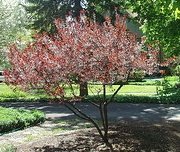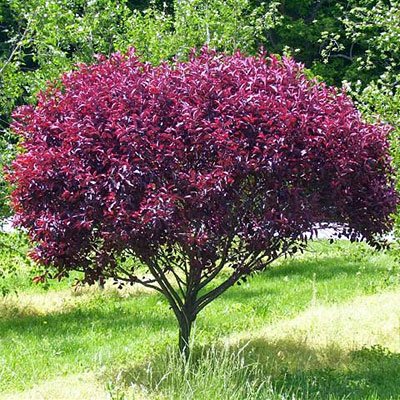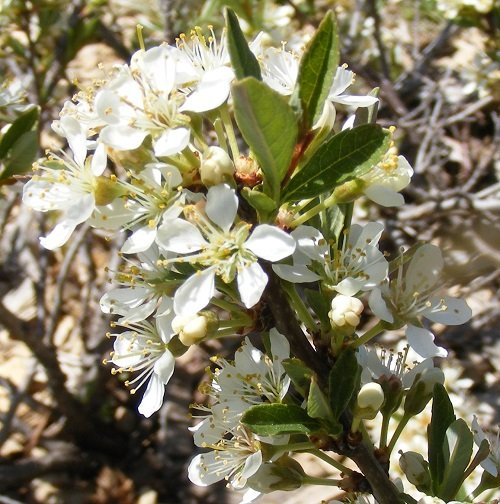Sandcherry
Purple Leaf Sandcherry or Red Leaf plum are a cross between Cherry Plum and Sand Cherry. Whether grown as a bush or shrubby tree, Sandcherry lends a unique rich purple color to your landscape and gardens.
Purple Leaf Sandcherry Prunus x cistena
Hardiness Zones: Zones 3-7
Light Requirements: Full Sun to Part Shade
Water Requirements: Average water requirements, is not drought tolerant.
Mature Height: 7-10 feet
Mature Spread: 5-7 feet
Shape: Upright rounded
Growth Rate: Moderately fast
Soil Preference: Tolerant of most soil conditions, preferring a loamy or sandy moist well drained soil
Foliage: Deep red purple foliage
Blooms: Tiny pink-white flowers in clusters April into May
Fruit: Deep purple fruit
Disease and Insects: Somewhat susceptible to insects and disease
Fertilize: Does not typically need feeding in good soil conditions. Apply a half cup 10-10-10 granular fertilizer at the base of the shrub
Pruning: Prunes well to control shape or size. Prune after flowering.
Purpleleaf Sandcherry is a tall shrub grown for it’s unique foliage color. The leaves open bright red in spring and remain intensely red purple all summer. By autumn the leaves turn more brilliant red. In April the shrub is covered with fragrant small pink blushed blooms into May. A small amount of sour fruits are produced that attract birds but also may be used for jams and jellies.
Whether grown as a shrub, specimen or pruned to a small tree form, Purpleleaf Sandchery is a wonderful addition to any landscape for season long color. Sandcherry takes well to pruning to control shape or size. However it does not live as long as many shrubs and small trees and may begin to decline after 10 years.
Purpleleaf Sandcherry is a cross between Prunus pumila and Prunus cerasifera. Prunus cerasifera, commonly known as Purpleleaf Plum, is a larger but similar version that can grow to 25’ high and wide in a rounded shape. It also grows fairly quickly, which tends to shorten a shrubs life.
Purple Leaf Sandcherry Prunus x cistena Dark Star
Hardiness Zones: Zones 3-9
Light Requirements: Full Sun to Part Sun
Water Requirements: Requires regular watering, more often in heat and drought conditions. Is not drought tolerant.
Mature Height: 5 feet
Mature Spread: 4 feet
Shape: Upright and spreading
Growth Rate: Moderate
Soil Preference: Tolerant of most soil conditions, preferring a loamy or sandy moist well drained soil
Foliage: Deep red purple to maroon foliage
Blooms: Tiny pink-white flowers in clusters in spring
Fruit: Deep purple fruit
Disease and Insects: Somewhat susceptible to insects and disease
Fertilize: Does not typically need feeding in good soil conditions. Apply a half cup 10-10-10 granular fertilizer at the base of the shrub
Pruning: Prunes well to control shape or size. Prune after flowering.
Darkstar is a really nice compact Sandcherry with dense branching. The maroon purple leaves hold great color all summer. This improved compact variety is a Monrovia exclusive. Leaves emerge red in spring, maturing to a deep green burgundy red that remains rich all summer.
Minimal fruiting in late summer. Prune in late winter as necessary. Prunes well to control size or to shape into a lovely tree form. Not especially fussy about soil and is very tolerant of urban pollution and inner city conditions. Expect Darkstar to remain healthy for at least 20 years.
Purple Leaf Sandcherry Prunus bessyei ‘Pawnee Buttes’ Western Sandcherry
Hardiness Zones: Zones 3-8
Light Requirements: Full Sun to Part Sun
Water Requirements: Moderate water needs, very drought tolerant
Mature Height: 15-18 inches
Mature Spread: 4-6 feet
Shape: Low and spreading
Growth Rate: Moderate
Soil Preference: Tolerant of most soil conditions, preferring a well drained soil
Foliage: Deep red purple to maroon foliage
Blooms: White flowers in clusters
Fruit: Abundant black cherry fruits
Disease and Insects: Somewhat susceptible to insects and disease
Fertilize: Does not typically need feeding. Apply good compost in autumn.
Pruning: Prunes well to control shape or size. Prune after flowering or very early in spring before flowering.
Clusters of white blooms are prolific on this Sandcherry. Low growing, ‘Pawnee Buttes’ offers fragrant blooms and all season foliage color. Silvery green leaves in summer give way to a spectacular ruby red in autumn. Leaves are elegantly long ovals held upright on graceful spreading branches. A beautiful groundcover and erosion control shrub. May mildew in too much shade.
Abundant fruits attract birds, butterfiles and wildlife and are excellent to make jellies or pie. Give ‘Pawnee Buttes’ some room as it does love to spread out a bit.Prune a few large branches down to about 6 inches every few years. It responds well to rejuvenation pruning. After 5 to 10 years you can prune the entire plant down to under 18”. although ‘Pawnee Buttes’ is native to Colorado. Although best in the West and Southwest, in had done well across the Midwest.






